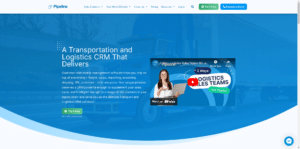Understand my sales pipeline?
Are you kidding me? I don’t want to understand my sales pipeline, I want to use my sales pipeline to make more money. It’s my job as sales manager to sell my company’s products and services, not talk about how I feel or try to understand my pipeline.
This is a mistake.
As you’ll soon see, understanding your sales pipeline is a simple way to boost your revenue. In fact, you’ll be able to increase your revenue on demand.
What's a sales pipeline?
There’s a misconception that your sales pipeline and sales funnel are one and the same. If you’re a sophisticated seller, you know the difference between the two.
But it’s easy to mix the two up.
Okay then, what’s the difference between a sales pipeline and a sales funnel?
- Sales pipeline: Your pipeline refers to the steps taken by salespeople in the sales process — prospecting, request for information, pitch, negotiation, decision, etc. The steps in your pipeline vary depending on your industry, but the focus is the same. Your sales pipeline is a micro-level process that guides sellers through the buyer’s journey.
- Sales funnel: This describes the steps taken by the customer on their end as they move through the buyer’s journey (e.g., awareness, desire, research, decision). This is a macro-level process that describes the steps your prospects take as they work towards a buying decision.
The sales pipeline is oriented around the steps you can take to get your deals to the finish line. These are the areas within your control.
What does that mean?
Well, if you’re managing your sales pipeline properly, only qualified candidates make it to the next step in the process. If prospects can’t be bothered to answer your questions, there’s no reason they should receive a pitch from you.
See what I mean?
Here’s why your sales pipeline is so valuable.
The hidden value of your sales pipeline
Your sales pipeline is a treasure trove of data. Using this data, you can help your organization identify the routes to more revenue.
What kind of data are we talking about here?
- Engagement by lead source/channel
- Conversions by lead source/channel
- Revenue by lead source/channel
- Profit by lead source/channel
- Average order values by lead source/channel
- Monthly recurring revenue by lead source/channel
- Churn rate by lead source/channel
How do you get this data?
You get it from your sales team! If you’re a sales manager using a CRM, track deal flow for each of your salespeople, monitoring their in-progress deals.
These are simple details like:
- Prospect responsiveness throughout the sales process (eager, aloof, unresponsive, prudent, etc.)
- Which lead source/channel produces the greatest amount of conversions (sorted by channel)
- The value of your closed deals, in aggregate, sorted by lead source/channel
- The lead source/channel that produces the most revenue and profit
- Which lead source/channel has the greatest amount of customer churn (e.g., customers calling to cancel or terminate their account)
- Which lead source has the greatest number of upsells, cross-sells, down sells, etc.?
This doesn’t need to be complicated, in fact, it shouldn’t be. If you’re the sales manager, you’ll want to make it easy for your sales reps to track this data.
Easy gets done.
If you understand your sales pipeline, you can use this intel to improve the performance of your sales pipeline, consistently increasing revenue and profit margins year-over-year.
What can you do with this data?
- Influence marketing spending so it’s oriented around the lead sources and channels that produce the most revenue or are the most profitable
- Amplify conversion rates from ideal lead sources and channels, decreasing your cost per lead and increasing the return on ad spend from marketing. Executives view both departments as rockstars
- Avoid lead sources or channels that increase revenue but decrease profits (due to heavy discounts)
- Identify the problem customers that produce 80% of the losses your company experiences (e.g., churn, refunds, discounts, etc.).
- Flush out predatory customers, creating internal case studies and blacklists you can use to filter out problem prospects
All of this sounds amazing.
Am I saying that a little bit of intel is all you need to be able to generate more revenue from your sales pipeline?
Absolutely.
Generating more revenue from your sales pipeline
What are the practical steps you need to take to make this happen? How do you generate more revenue from your sales pipeline?
It’s unbelievable.
Not because it’s difficult but because it’s so simple. The strategies and tactics involved are simple to follow. Let’s take a look at how it’s done.
- Choose metrics and KPIs: Which pieces of data indicate that your sales pipeline is profitable? This could be your conversion rate by channel, revenue per customer, or your customer churn rate. It could be something else; the point is, you have metrics that tell you what success looks like.
- Create ownership of metrics: You’ll want to align your team with the metrics you have control over. Take revenue per customer, for example. Sales and marketing can take ownership of this metric because they’re directly responsible for most of the sales and marketing activity in the company.
- Tie metrics to actions: Let’s say your sales team is responsible for the revenue per customer If you notice that revenue per customer begins to decrease, you’ll want to outline a series of action steps you will take to turn things around. For example, you could offer profitable customer incentives, share educational materials, pitch irresistible offers, etc.
- Make actions easy for sales: These action steps should be sales-ready. Your sales reps should be able to take the action steps you want with minimal steps or light customization. This shouldn’t be a burden as that will demotivate your salespeople.
- Incentivize actions: Give your salespeople incentives for taking these actions. If these actions are tied to metrics, and you’ve confirmed that they’ll improve the metrics you’re responsible for, incentives make financial sense. It’s a simple way to equalize your sales team’s earning potential.
- Reward results: Reward your salespeople again once they get deals over the finish line. Give them the tools and resources they need to close deals but show them that you will reward them for closing customers and getting things done.
- Run a post-mortem analysis: If you’re the manager, you’ll want to complete a post-mortem regularly, whether that’s weekly, monthly, or quarterly. This is a concise summary that outlines what went wrong (and needs to be fixed), what went well (and should be repeated), and what failed to produce any meaningful results (and should be discontinued).
Then you repeat the process.
Can you see what’s happening here? When you take the time to analyze and understand your sales pipeline, you gain the kind of intel that generates more revenue.
You learn about:
- Where your salespeople should spend their time and attention
- Revenue leaks (cause and location) that need to be plugged
- What prospects are looking for, which is essential as the market evolves rapidly over time
- Cost-saving opportunities that reduce expenses (e.g., avoiding predatory customers, eliminating discounts)
- The specific actions your salespeople need to take to increase revenue systematically
- Revenue generating, profit decreasing offerings that trick your company into selling its way out of losses
- Products or services that produce the most profit
Wait a minute.
How are you supposed to track all of this? It’s not like writing this down on post-it notes or pads of paper is a viable, long-term strategy.
That’s why you need a CRM tool.
With the right CRM, your sales team will be able to track all of this and more. Even better, you’ll be able to set this up for your sales team, so it’s easy to track. You’ll want to give your sales team quick wins and immediate rewards, so they’re motivated to perform.
Remember, easy gets done.
If you’re looking for a simple system you can use, a CRM tool is the way to go. It enables you to set up your metrics and assign ownership of those metrics to the right teams. It also allows you to track performance at the team, group, and individual levels.
With a CRM tool, you get comprehensive or bite-sized breakdowns instantly.
Understanding your sales pipeline is the key to more profit
You already know what a sales pipeline is; now you know how to use your sales pipeline to attract more customers, close more deals, and generate revenue.
The secret is buried in your data.
Your sales pipeline is a treasure trove of data. Using your data, you can help your organization identify clear routes to more revenue and profit.
As we’ve seen, understanding your sales pipeline means you have the intel you need to improve the performance consistently over time. With consistent analysis, you’ll find you’re able to increase your revenue and profit margins year-over-year.




